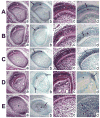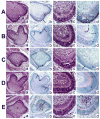Identification of novel genes expressed during mouse tooth development by microarray gene expression analysis
- PMID: 17626284
- PMCID: PMC4457363
- DOI: 10.1002/dvdy.21226
Identification of novel genes expressed during mouse tooth development by microarray gene expression analysis
Abstract
To identify genes heretofore undiscovered as critical players in the biogenesis of teeth, we have used microarray gene expression analysis of the developing mouse molar tooth (DMT) between postnatal day (P) 1 and P10 to identify genes differentially expressed when compared with 16 control tissues. Of the top 100 genes exhibiting increased expression in the DMT, 29 were found to have been previously associated with tooth development. Differential expression of the remaining 71 genes not previously associated with tooth development was confirmed by quantitative reverse transcription-polymerase chain reaction analysis. Further analysis of seven of the latter genes by mRNA in situ hybridization found that five were specific to the developing tooth in the craniofacial region (Rspo4, Papln, Amtn, Gja1, Maf). Of the remaining two, one was found to be more widely expressed (Sp7) and the other was found to be specific to the nasal serous gland, which is close to, but distinct from, the developing tooth (Vrm).
(c) 2007 Wiley-Liss, Inc.
Figures



Similar articles
-
Identification of differential microRNA expression during tooth morphogenesis in the heterodont dentition of miniature pigs, SusScrofa.BMC Dev Biol. 2015 Dec 29;15:51. doi: 10.1186/s12861-015-0099-0. BMC Dev Biol. 2015. PMID: 26715101 Free PMC article.
-
Differentially expressed genes in the lens of mimecan-null mice.Mol Vis. 2004 Jun 17;10:403-16. Mol Vis. 2004. PMID: 15215744
-
Differential gene expression profiling of the molar tooth germ in peroxisome proliferator-activated receptor-alpha (PPAR-alpha) knockout mouse and in wild-type mouse: molar tooth phenotype of PPAR-alpha knockout mouse.Eur J Oral Sci. 2009 Apr;117(2):93-104. doi: 10.1111/j.1600-0722.2009.00615.x. Eur J Oral Sci. 2009. PMID: 19320717
-
Amelogenin in cranio-facial development: the tooth as a model to study the role of amelogenin during embryogenesis.J Exp Zool B Mol Dev Evol. 2009 Jul 15;312B(5):445-57. doi: 10.1002/jez.b.21255. J Exp Zool B Mol Dev Evol. 2009. PMID: 19097165 Review.
-
Leveraging Spatial Transcriptomics to Decode Craniofacial Development.Genes (Basel). 2025 May 3;16(5):557. doi: 10.3390/genes16050557. Genes (Basel). 2025. PMID: 40428379 Free PMC article. Review.
Cited by
-
Transcriptional Profiling of Early and Late Phases of Bovine Tuberculosis.Infect Immun. 2022 Feb 17;90(2):e0031321. doi: 10.1128/IAI.00313-21. Epub 2021 Dec 13. Infect Immun. 2022. PMID: 34898250 Free PMC article.
-
Analysis of a limb-specific regulatory element in the promoter of the link protein gene.Biochem Biophys Res Commun. 2019 Oct 22;518(4):672-677. doi: 10.1016/j.bbrc.2019.08.104. Epub 2019 Aug 27. Biochem Biophys Res Commun. 2019. PMID: 31470976 Free PMC article.
-
Novel mutations in GJA1 cause oculodentodigital syndrome.J Dent Res. 2008 Nov;87(11):1021-6. doi: 10.1177/154405910808701108. J Dent Res. 2008. PMID: 18946008 Free PMC article.
-
Sp6/Epiprofin is a master regulator in the developing tooth.Biochem Biophys Res Commun. 2021 Dec 3;581:89-95. doi: 10.1016/j.bbrc.2021.10.017. Epub 2021 Oct 9. Biochem Biophys Res Commun. 2021. PMID: 34662808 Free PMC article.
-
Most canine ameloblastomas harbor HRAS mutations, providing a novel large-animal model of RAS-driven cancer.Oncogenesis. 2019 Feb 11;8(2):11. doi: 10.1038/s41389-019-0119-1. Oncogenesis. 2019. PMID: 30741938 Free PMC article.
References
-
- Agnello D, Lankford CS, Bream J, Morinobu A, Gadina M, O’Shea JJ, Frucht DM. Cytokines and transcription factors that regulate T helper cell differentiation: new players and new insights. J Clin Immunol. 2003;23:147–161. - PubMed
-
- Aldred MJ, Savarirayan R, Crawford PJM. Amelogenesis imperfecta: a classification and catalogue for the 21st century. Oral Dis. 2003;9:19–23. - PubMed
-
- Chai Y, Maxson RE. Recent advances in craniofacial morphogenesis. Dev Dyn. 2006;235:2353–2375. - PubMed
Publication types
MeSH terms
Substances
Grants and funding
LinkOut - more resources
Full Text Sources
Molecular Biology Databases
Miscellaneous

